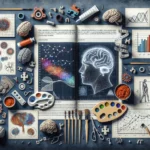Unlocking the Mysteries of Intelligence and Art: A Deep Dive into the IQ-Artistic Ability Connection
Have you ever wondered if there’s a link between raw intelligence and the ability to create stunning works of art? The question has intrigued educators, psychologists, and creatives for years, leading to a multitude of studies aimed at uncovering the truth. One such groundbreaking research effort that has caught the attention of many is the study titled “Studies on the relationship between IQ and artistic abilities.”
For decades, the concept of Intelligence Quotient (IQ) has been a standardized measure to gauge an individual’s cognitive abilities. It’s often thought that a high IQ correlates with academic success and complex problem-solving skills. But does it have any bearing on a person’s artistic capabilities?
The aforementioned study approached this inquiry with scientific rigor and an innovative lens. Researchers meticulously examined a broad demographic, encompassing varied age groups and backgrounds to ensure their findings weren’t limited to a narrow slice of the population. By doing so, they aimed to present a more holistic understanding of the IQ-artistry relationship.
This comprehensive study enlisted a range of artistic disciplines, including visual arts, music, dance, and creative writing. It employed a variety of assessments to measure artistic aptitude, such as practical performance tests, portfolio reviews, and peer evaluations. Simultaneously, participants underwent standard IQ testing to establish a baseline for their cognitive abilities.
The findings of the study were nothing short of fascinating. Contrary to the popular notion that intelligence and artistry are direct correlates, the results indicated a more nuanced relationship. While some artistic fields showed a mild correlation with higher IQ scores, others appeared to thrive independently of cognitive prowess.
For instance, in the realm of visual arts, the study revealed a moderate connection between IQ and technical skill—those with higher IQs often demonstrated better control over fine motor skills and detail-oriented tasks. However, when it came to creativity and innovation within visual media, the correlation with IQ was less pronounced.
On the other hand, the area of music showcased a different trend. Musical ability, particularly in understanding and manipulating complex rhythms and harmonies, showed a stronger correlation with higher IQ levels. This aspect underscores the cognitive engagement required in decoding and creating intricate musical compositions.
Minutely, the study dissected the layers of artistic proficiency. It considered not only the innate talent and learned skills but also the role of personality traits such as openness to experience, curiosity, and tolerance for ambiguity. These characteristics often foster creativity and can be independent of traditional intelligence measures.
In dissecting this relationship, the research sheds light on the importance of diverse educational approaches to nurture both intelligence and artistic potentials. Traditional education systems focusing heavily on IQ-related achievements might overlook the development of creative abilities in individuals. As the study concludes, there is a pressing need to celebrate and support multiple intelligences, recognizing that intellectual and artistic capabilities can manifest in a myriad of forms.
Moreover, the implications of this study reach beyond academia into the workplace. Understanding the diverse ways in which intelligence and creativity intertwine can help in crafting better teams, fostering innovation, and appreciating the unique contributions of every individual irrespective of their IQ scores.
To sum up, the “Studies on the relationship between IQ and artistic abilities” offers groundbreaking insights into the complex tapestry of human intelligence and creativity. Its nuanced conclusions challenge preconceived notions and encourage a broader perspective on how we define and nurture talent across various spectrums. For anyone captivated by the interplay of intellect and imagination, this study is an invaluable touchstone that marks an essential stride in our ongoing quest to grasp the full expanse of human potential.

